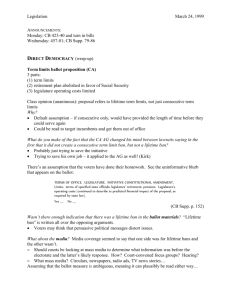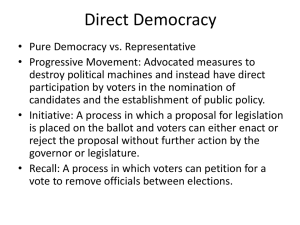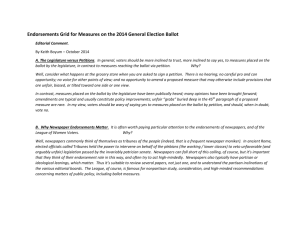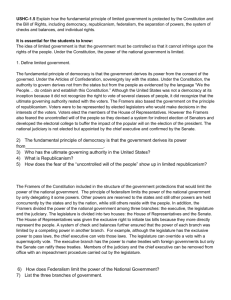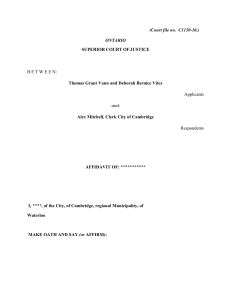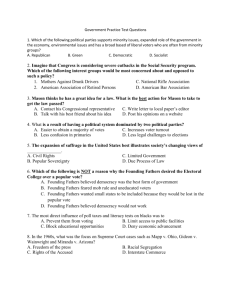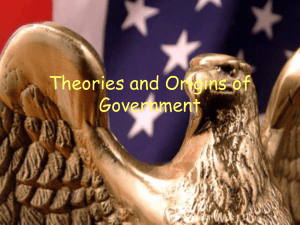California State University, Sacramento
advertisement
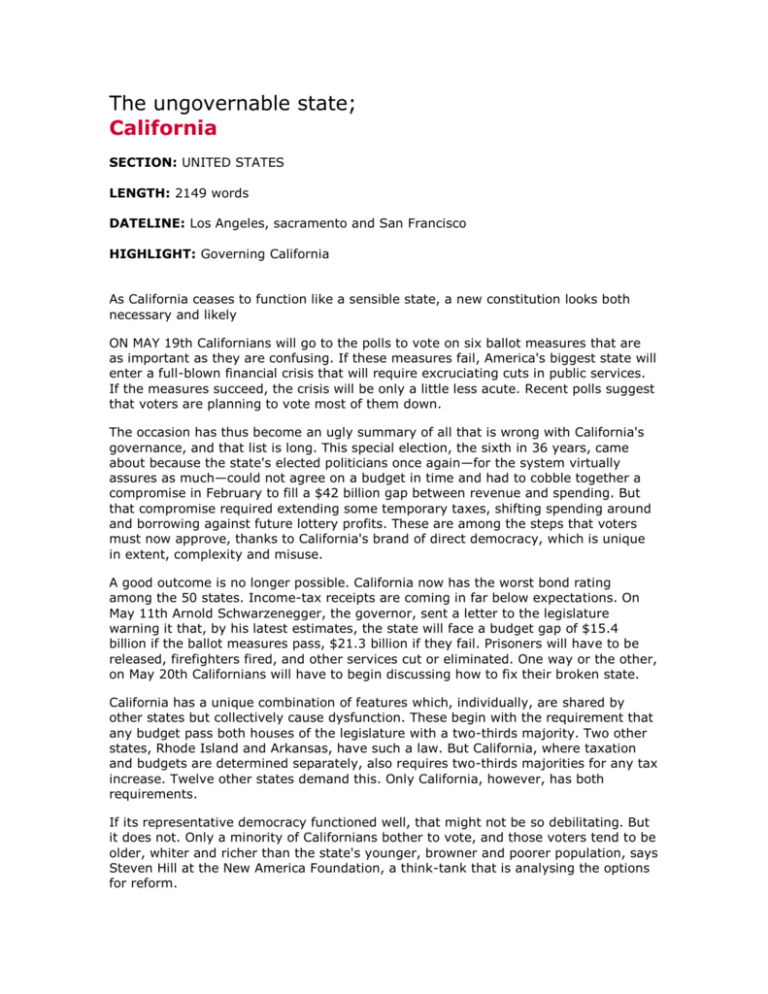
The ungovernable state; California SECTION: UNITED STATES LENGTH: 2149 words DATELINE: Los Angeles, sacramento and San Francisco HIGHLIGHT: Governing California As California ceases to function like a sensible state, a new constitution looks both necessary and likely ON MAY 19th Californians will go to the polls to vote on six ballot measures that are as important as they are confusing. If these measures fail, America's biggest state will enter a full-blown financial crisis that will require excruciating cuts in public services. If the measures succeed, the crisis will be only a little less acute. Recent polls suggest that voters are planning to vote most of them down. The occasion has thus become an ugly summary of all that is wrong with California's governance, and that list is long. This special election, the sixth in 36 years, came about because the state's elected politicians once again—for the system virtually assures as much—could not agree on a budget in time and had to cobble together a compromise in February to fill a $42 billion gap between revenue and spending. But that compromise required extending some temporary taxes, shifting spending around and borrowing against future lottery profits. These are among the steps that voters must now approve, thanks to California's brand of direct democracy, which is unique in extent, complexity and misuse. A good outcome is no longer possible. California now has the worst bond rating among the 50 states. Income-tax receipts are coming in far below expectations. On May 11th Arnold Schwarzenegger, the governor, sent a letter to the legislature warning it that, by his latest estimates, the state will face a budget gap of $15.4 billion if the ballot measures pass, $21.3 billion if they fail. Prisoners will have to be released, firefighters fired, and other services cut or eliminated. One way or the other, on May 20th Californians will have to begin discussing how to fix their broken state. California has a unique combination of features which, individually, are shared by other states but collectively cause dysfunction. These begin with the requirement that any budget pass both houses of the legislature with a two-thirds majority. Two other states, Rhode Island and Arkansas, have such a law. But California, where taxation and budgets are determined separately, also requires two-thirds majorities for any tax increase. Twelve other states demand this. Only California, however, has both requirements. If its representative democracy functioned well, that might not be so debilitating. But it does not. Only a minority of Californians bother to vote, and those voters tend to be older, whiter and richer than the state's younger, browner and poorer population, says Steven Hill at the New America Foundation, a think-tank that is analysing the options for reform. Those voters, moreover, have over time "self-sorted" themselves into highly partisan districts: loony left in Berkeley or Santa Monica, for instance; rabid right in Orange County or parts of the Central Valley. Politicians have done the rest by gerrymandering bizarre boundaries around their supporters. The result is that elections are won during the Republican or Democratic primaries, rather than in runoffs between the two parties. This makes for a state legislature full of mad-eyed extremists in a state that otherwise has surprising numbers of reasonable citizens. And that is why sensible and timely budgets have become almost impossible, says Jim Wunderman, president of the Bay Area Council, an association of corporate bosses. Because the Republicans are in a minority in the legislature, they have no sway until budget time, when they suddenly hold veto power thanks to the two-thirds requirement. Because in the primaries they have run on extremist platforms against other Republicans, they have no incentive to be pragmatic or moderate, and tend simply to balk. What was unusual about this year's deadlock was only its "record lateness", says Mr Wunderman, which amounted to an "anti-stimulus" that negated much of the economic-recovery plan coming from Washington, DC. "No real conversation is possible on anything that matters," he says, whether it be California's fraught water supply, its barbaric prison conditions or its teetering public education. Representative democracy is only one half of California's peculiar governance system. The other half, direct democracy, fails just as badly. California is one of 24 states that allow referendums, recalls and voter initiatives. But it is the only state that does not allow its legislature to override successful initiatives (called "propositions") and has no sunset clauses that let them expire. It also uses initiatives far more, and more irresponsibly, than any other state. Direct democracy in America originated, largely in the Western states, during the Populist and then Progressive eras of the late 19th and early 20th century. It came to California in 1911, when Governor Hiram Johnson introduced it. At first, it made sense. The Southern Pacific Railroad dominated politics, society and the courts in the young frontier state, and direct democracy would be a welcome check and balance. The state in 1910 had only 2.4m residents, and 95% of them were white. (Today it has about 37m residents, and less than half are white.) A small, homogenous and informed electorate was to make sparing and disciplined use of the ballot to keep the legislature honest, rather as in Switzerland. Sparing and disciplined it stayed until the 1970s. But then came a decade of polarisation and voter mistrust. In 1978 Californians sparked a nationwide "tax revolt" by passing Proposition 13, which drastically limited property taxes and placed a permanent straitjacket on state revenues. That launched an entire industry of signature-gatherers and marketing strategists that now puts an average of ten initiatives a year on the ballot, as Mark Baldassare, the boss of the non-partisan Public Policy Institute of California, has calculated. In 2003 direct democracy reached a new zenith—or nadir, some might say—when Californians "recalled" their elected and sitting governor, Gray Davis, and replaced him with Mr Schwarzenegger. The minority of eligible Californians who vote not only send extremists to Sacramento, but also circumscribe what those representatives can do by deciding many policies directly. It is the voters who decide, for instance, to limit legislators' terms in office, to mandate prison terms for criminals, to withdraw benefits from undocumented immigrants, to spend money on trains or sewers, or to let Indian tribes run casinos. Through such "ballot-box budgeting", a large share of the state's revenues is spoken for before budget negotiations even begin. "The voters get mad when they vote to spend a ton of money and the legislature can't then find the money," says Jean Ross of the California Budget Project, a research outfit in Sacramento. Indeed, voters being mad is the one constant; the only proposition that appears certain to pass on May 19th would punish legislators with pay freezes in budget-deficit years. More than half of the initiatives don't pass, and some that do are sensible. But much of the system has been perverted into the opposite of what Hiram Johnson intended. It is not ordinary citizens but rich tycoons from Hollywood or Silicon Valley, or special interests such as unions for prison guards, teachers or nurses, that bankroll most initiatives onto the ballots. Then comes a barrage of television commercials, junk mail and robo-calls that leave no Californian home unmolested and the great majority confused. Propositions tend to be badly worded, with double negatives that leave some voters thinking they voted for something when they really voted against. One eloquent English teacher in Los Angeles recently called a radio show complaining that, after extensive study, she could not understand the ballot measures on grounds of syntax. The broken budget mechanism and the twin failures in California's representative and direct democracy are enough to guarantee dysfunction. The sheer complexity of the state exacerbates it. Peter Schrag, the author of "California: America's High-Stakes Experiment", has counted about 7,000 overlapping jurisdictions, from counties and cities to school and water districts, fire and park commissions, utility and mosquitoabatement boards, many with their own elected officials. The surprise is that anything works at all. As a result, there is now a consensus among the political elite that California's governance is "fundamentally broken" and that the state is "ungovernable, unless we make tough choices", as Antonio Villaraigosa, the mayor of Los Angeles and a likely candidate for governor next year, puts it. What are those choices? Incremental reform, says one set of analysts. Darrell Steinberg, a thoughtful Democrat who is the current leader of the state Senate, says that the dysfunction is often overstated, since the system was deliberately designed "to ensure that change occurs slowly". He believes that several piecemeal reforms already slated will fix most of the problem. So does California Forward, a bipartisan think-tank supported by several of the state's éminences grises. A change to districting rules should end gerrymandering, starting next year. And there is talk of open primaries in which people vote irrespective of their party affiliation, and then elect a candidate in a run-off between the top two vote-getters, whether from the same party or not. Together, these two steps would make the state's representative politics more moderate, says James Mayer, California Forward's director. Representatives should also have longer terms in office, he thinks, to reduce the permanent turnover that pits greenhorn legislators against savvy and entrenched lobbyists. Many others, however, now believe that California needs to start from scratch, with a fully-fledged constitutional convention. California's current constitution rivals India's and Alabama's for being the longest and most convoluted in the world, and is several times longer than America's. It has been amended or revised more than 500 times and now, with the cumulative dross of past voter initiatives incorporated, is a document that assures chaos. Calls for a new constitution have resurfaced throughout the past century, but never went far. That changed last August, as the budget negotiations were once again going off the rails, when Mr Wunderman of the Bay Area Council renewed the call for a convention and received an astonishing outpouring of support. Mr Schwarzenegger has called a constitutional convention "a brilliant idea" and thinks it is "the right way to go". (The new constitution would take effect well after he leaves office.) Most encouragingly, says Mr Wunderman, nobody, not even the so-called special interests, has yet come out against a convention. To the extent that there is scepticism at all, it is not about the idea of a new and cleaner constitution but about the process that might lead to it. If a convention set out to rewrite the entire constitution, it would end in the usual war over hot-button social issues such as gay marriage or the perennial Californian fight over water. And there is concern that "the nutwings are the ones who will show up, not the soccer moms," as Ms Ross of the California Budget Project puts it. The same partisan extremists bickering about the same controversies would lead nowhere. To address these concerns, the Bay Area Council, which has become the driving force behind the scheme, has put forth two ideas. First, delegates to the convention should be chosen through the general jury pool to ensure that the whole population, as opposed to partisans or voters, is represented. Second, the scope of the constitutional convention would be explicitly limited to governance issues and the budget mechanism and would exclude all others. This should enable reform in the most vital and interconnected areas. These are: reducing the two-thirds requirement for budgets and taxes; mandating two-year as opposed to annual budgets; giving local governments more access to local revenues; creating less partisan districts and primary elections; disciplining the process of direct democracy with new rules about signature collection; and introducing a "sunset" commission, as Texas has, that would gradually retire overlapping jurisdictions and offices to achieve something more manageable. The plan is to introduce voter initiatives in next year's ballot calling for a constitutional convention, to have the convention the following year, and to put the new constitution on a ballot in 2012, when it would take effect. In the meantime both the incrementalists, such as California Forward, and the wholesale reformers, such as the Bay Area Council, are backing the propositions on next week's ballot. Even if they succeed, this would only temporarily reduce the urgency for radical reform; failure would cause intolerable pain.


